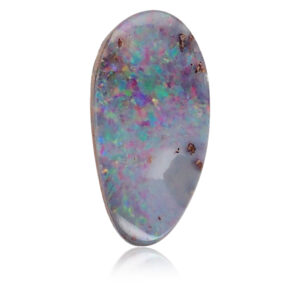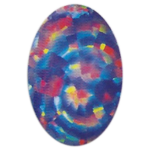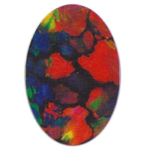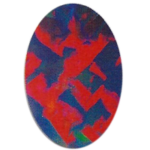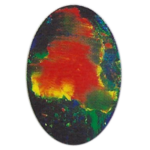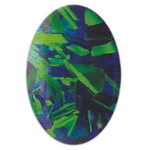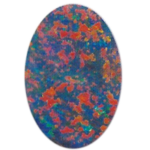FAQ : How is opal valued? What makes a good opal? What are the different patterns in opal? What faults can opal have that detract from its value? What is the play-of-colour? What should I look for in a good opal? How are opals valued? Why are some opals more expensive than others?
The value of an opal depends on many factors. The type of opal, body tone, brilliance, pattern, colour bar thickness, the play of colour, and faults all play important roles in determining the value.
Other important factors include the quality of the cut & polish, and the size of the stone. When being valued, opal is carefully examined and given a price ‘per carat’. The overall carat size of the stone will then determine the price of the opal.
Opal class
First of all, it is essential to identify the type of opal which is being valued. An opal doublet or triplet can be worth considerably less than a solid opal. Doublets and triplets are an ‘assembled’ stone which only contains a very thin slice of natural opal and are therefore generally much less valuable.
Body Tone
Body tone is one of the most important factors in the classification and valuation of opals. Body tone refers to the background or the ‘underlying colour’ of the opal, which ranges from black through dark to light. Generally opals with a black or dark body tone are more valuable than those with a white, light, or crystal body tone, because a stone with a darker body tone tends to display colours more vibrantly.

Above – AOGIA 1-9 body tone scale.
Black opal is the most prized opal and may realise prices over AUD $15,000 a carat. Boulder opals also have a dark body tone. White opals have a light body tone and are generally the least valuable form of opal.
The term crystal opal refers to the ‘diaphaneity’ (transparency) of an opal, not its crystal structure, and is defined as any type of opal which is translucent to transparent. (See image, below) Some crystal opal displays colour so intense, so dark, that the opal is referred to as ‘black crystal opal.’
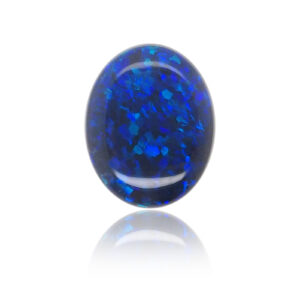
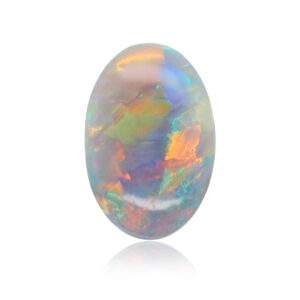
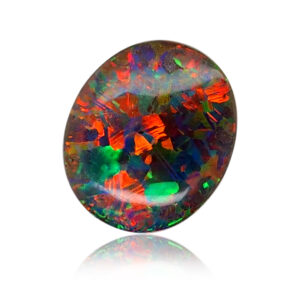
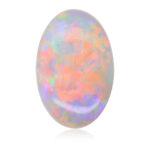
Above – Black Opal, Semi-black Opal, Boulder Opal, Crystal Opal
The play of colour
The phenomenon known as the “play-of-colour” is the brilliant range of the full spectrum of colours caused by the diffraction of white light by the internal structure of orderly arrayed spheres of silica. Red (fire) opal is generally more valuable than a mainly green opal which, in turn, is more valuable than a stone showing only blue colour. Nature does not produce a red colour as often as it does a blue or green. Red colouring is caused by larger microscopic silica spheres, whereas blue is caused by the more common small spheres.
Brilliance
Brilliance refers to the brightness and clarity of the colours displayed by opal, when the stone is viewed face-up. This ranges from brilliant , bright , to subdued or dull.
Pattern
The pattern of coloured segments, forming the play-of-colour of a precious opal, is unique to every individual opal. The distinctiveness and colour displayed by these segments determines the quality of the pattern of an opal.
Excellent patterns include;
- Harlequin, large sections of colour in which each colour segment is roughly the same size and shape, like a mosaic or chequerboard. A true harlequin pattern is extremely rare and highly sought after.
- Flagstone, large sections of colour with straight edges, in a random pattern
- Ribbon, narrow, parallel cascading lines of rolling colour
- Straw, random thin strips of overlapping colour
- Chinese Writing, thin strips of overlapping colour which resemble Chinese characters
- Picture stones, the intriguingly unique patterns of ‘novelty’ or ‘picture’ stones, which resemble an object, landscape, animal, person, etc.
Good patterns include;
- Floral – a random pattern of colour with good spread
- Rolling Flash – large sections of colour which roll across the stone as it turns
- Broad Flash – large sections of colour which flash as the stone turns
- Pinfire – tiny points or specks of colour
Poor patterns are indistinct, and are characterised by patterns featuring Moss and Grass.
Above patterns – left to right, Harlequin, Flagstone, Chinese Writing, Broad Flash, Straw, and Floral. ( Photos by Len Cram).
Colour bar
The thickness of the colour bar in opal is relative to the overall size and shape of the individual stone. Boulder opal typically has a very thin colour bar due to the way the opal is geologically formed. This should be taken into account when valuing the stone, however makes little difference to its appearance once set in jewellery.
Faults
Faults which can detract from the value of a finished opal are many and varied. A crack in the face can render almost worthless an opal that otherwise might have been worth a considerable amount per cart. Crazing, i.e. many small cracks in the opal’s face will also relegate the stone to worthless.
Sand and various other minerals can be found as inclusions in and/or under the colour bar, and in the potch of opals. Sand/sandstone inclusions in the potch (on the underside of the opal) will have no effect on the value of the opal.
Other faults include potch lines, webbing, (grey lines) and windows (sections devoid or lacking in colour). The consistency of colours and pattern when viewed from different directions also has an influence – when a stone “won’t face”, the colour only shows through on certain angles and otherwise has little colour. The visibility of potch or brown ironstone on the surface of the stone will also lead to a drop in value.
Conclusion
All the above factors are taken into account when valuing opal, however there is no substitute for experience. Truth be known, there is no standardised or set method for valuing opals, as each opal is extremely unique in terms of pattern, brightness, and colouring (unlike diamonds, which can be more accurately valued according to a set chart of colours, clarity, faults, etc.) Always ask for a certificate of valuation / authenticity with your opal, and get a second opinion from an experienced valuer if you are concerned about the value of your stone.
Sources :
- “Opal in South Australia”, Mines & Energy Resources, SA
- “Opal”, Qld Dept. of Mines & Energy
- The Australian Gemmologist, Vol21, #7, “Classification of Type 1 Natural Opal”, Joseph Schellnegger.

